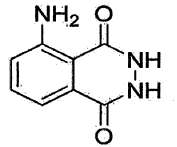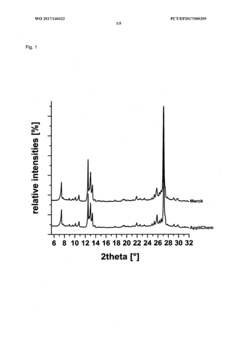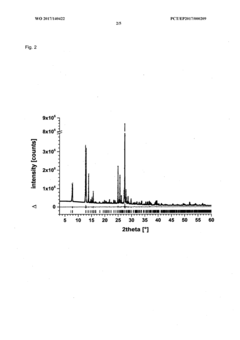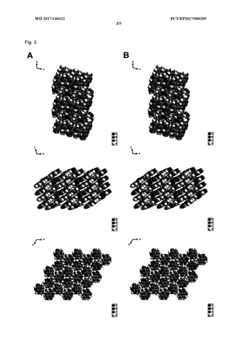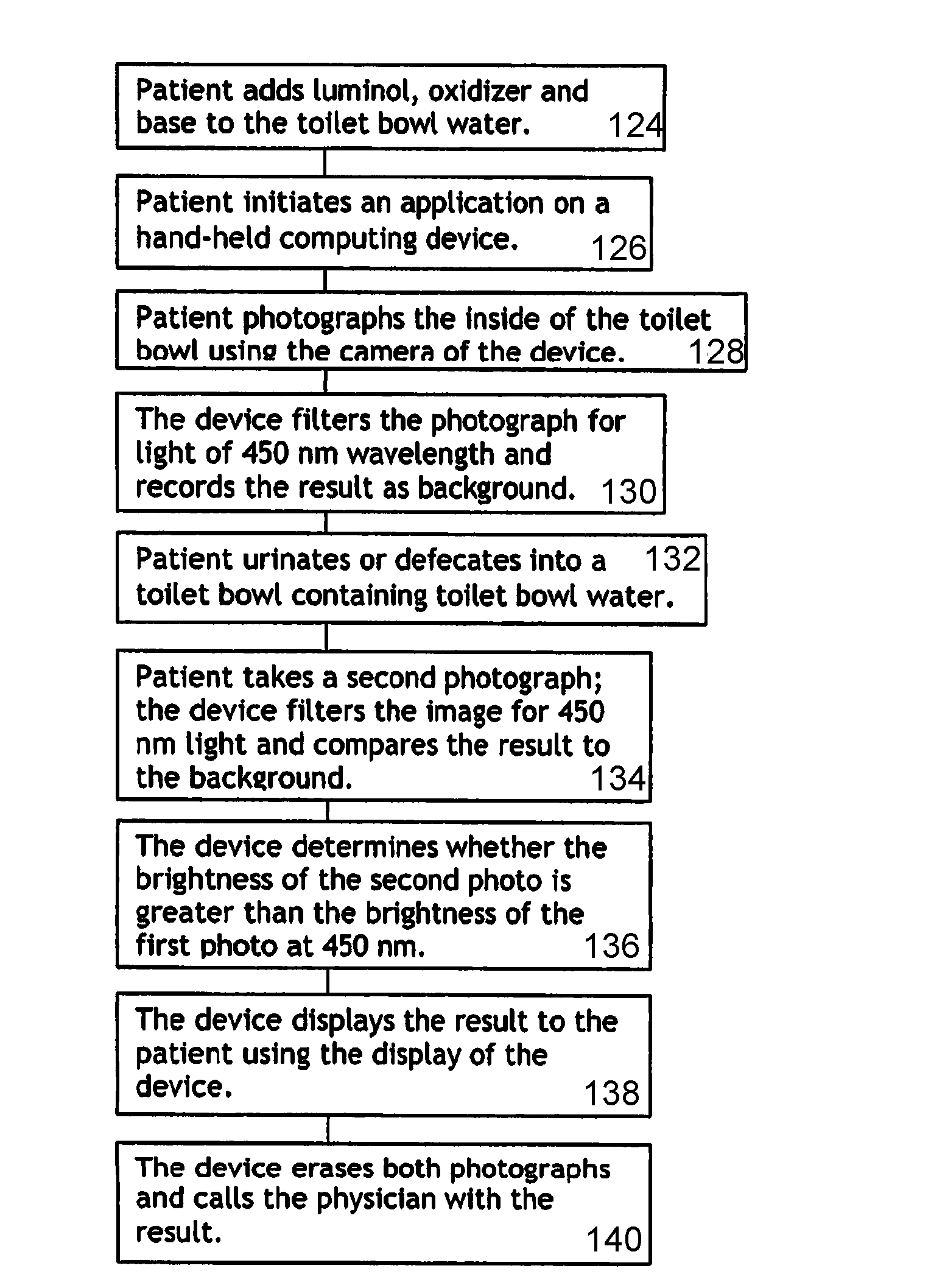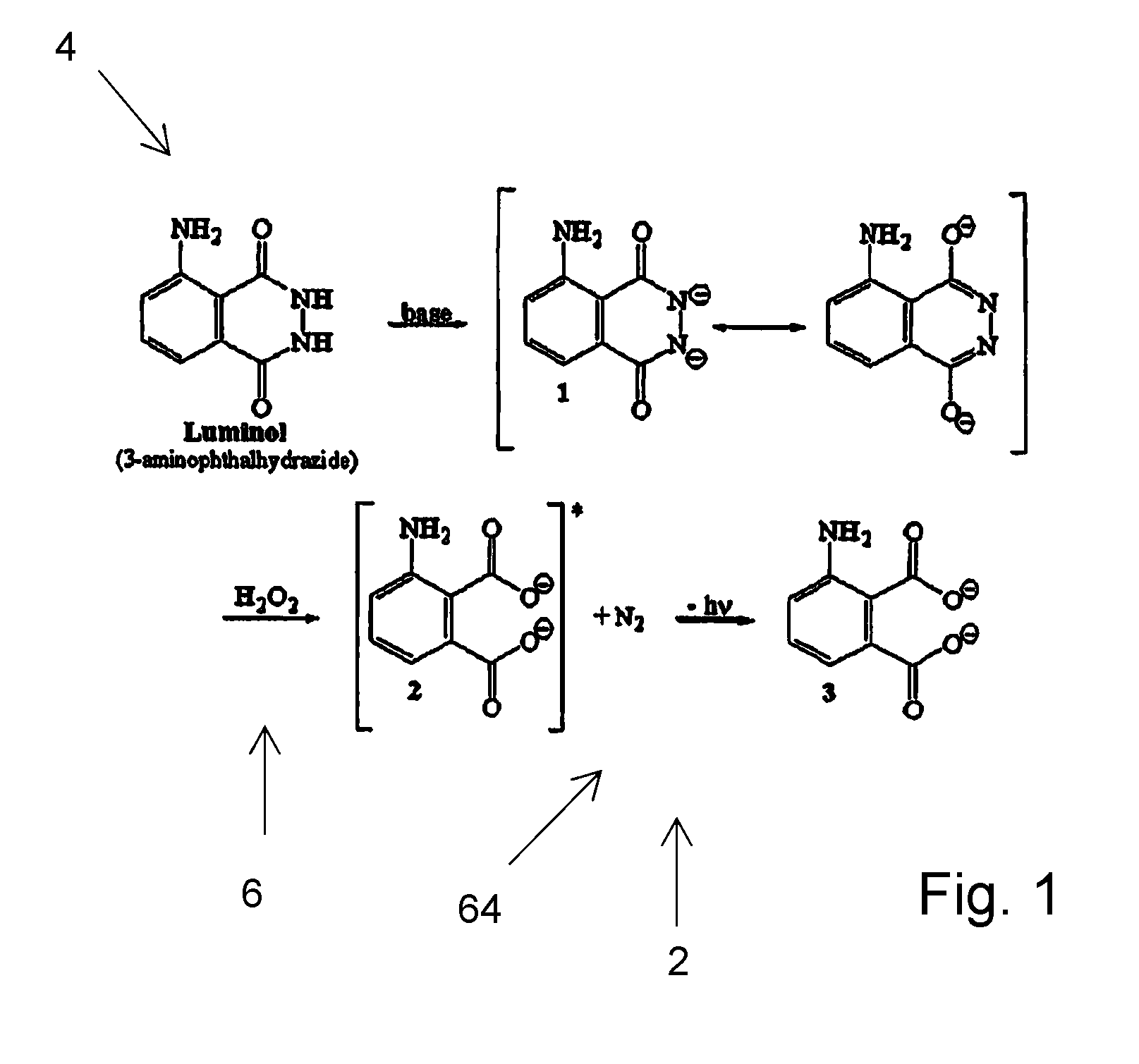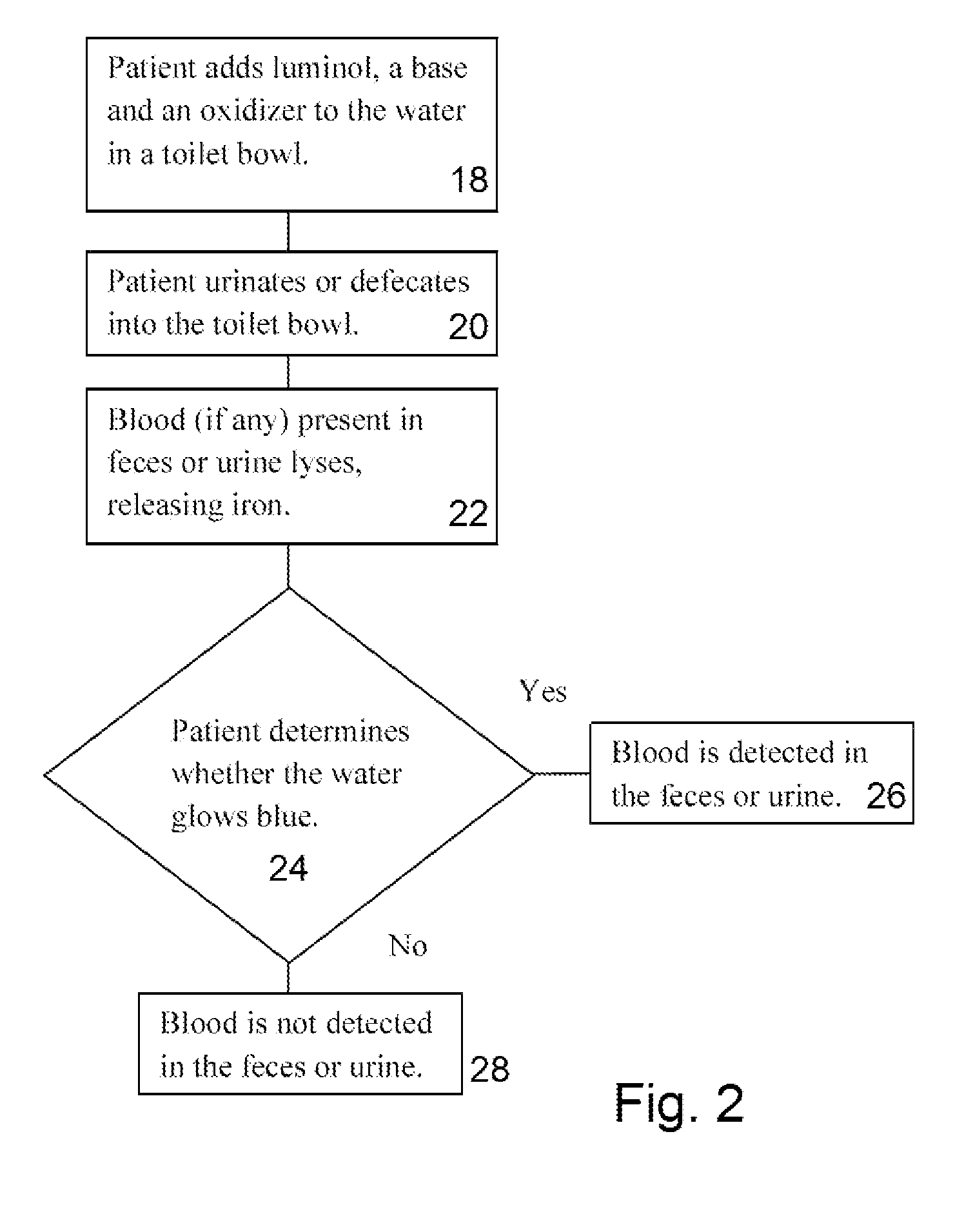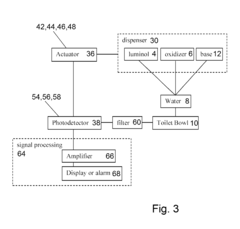How to Utilize Luminol in Water Contaminant Detection?
AUG 19, 20259 MIN READ
Generate Your Research Report Instantly with AI Agent
Patsnap Eureka helps you evaluate technical feasibility & market potential.
Luminol Detection Background
Luminol, a chemiluminescent compound, has been widely used in forensic science for blood detection since its discovery in the early 20th century. This versatile chemical has recently gained attention in the field of water quality monitoring due to its potential for detecting various contaminants. The principle behind luminol's effectiveness lies in its ability to emit light when oxidized, a process that can be triggered by certain substances present in contaminated water.
The background of luminol detection in water contaminant analysis stems from the growing need for rapid, sensitive, and cost-effective methods to assess water quality. Traditional water testing techniques often require complex equipment, extensive sample preparation, and lengthy analysis times. In contrast, luminol-based detection offers the possibility of real-time, on-site monitoring with minimal infrastructure requirements.
Luminol's application in water contaminant detection builds upon its established use in forensic science. Researchers have found that the compound's chemiluminescent properties can be harnessed to identify a range of pollutants, including heavy metals, organic compounds, and microbial contaminants. This versatility makes luminol an attractive option for comprehensive water quality assessment.
The development of luminol-based water contaminant detection methods has been driven by several factors. First, the increasing global concern over water pollution and its impact on human health and ecosystems has created a demand for more efficient monitoring tools. Second, advancements in sensor technology and data analysis have enabled the integration of luminol-based detection into portable and automated systems.
Recent studies have explored various approaches to optimize luminol's performance in water contaminant detection. These include modifying the chemical structure of luminol to enhance its sensitivity and selectivity, developing novel catalysts to amplify the chemiluminescent signal, and combining luminol with other detection techniques for multi-parameter analysis.
The potential applications of luminol in water contaminant detection are diverse. It can be used for monitoring drinking water quality, assessing industrial effluents, tracking pollution in natural water bodies, and even detecting biological warfare agents in water supplies. The adaptability of luminol-based methods to different water matrices and contaminant types makes it a promising tool for addressing a wide range of water quality challenges.
As research in this field progresses, the focus is shifting towards improving the specificity and quantitative capabilities of luminol-based detection systems. Scientists are working on developing more sophisticated algorithms and machine learning approaches to interpret the chemiluminescent signals and provide accurate contaminant identification and concentration measurements.
The background of luminol detection in water contaminant analysis stems from the growing need for rapid, sensitive, and cost-effective methods to assess water quality. Traditional water testing techniques often require complex equipment, extensive sample preparation, and lengthy analysis times. In contrast, luminol-based detection offers the possibility of real-time, on-site monitoring with minimal infrastructure requirements.
Luminol's application in water contaminant detection builds upon its established use in forensic science. Researchers have found that the compound's chemiluminescent properties can be harnessed to identify a range of pollutants, including heavy metals, organic compounds, and microbial contaminants. This versatility makes luminol an attractive option for comprehensive water quality assessment.
The development of luminol-based water contaminant detection methods has been driven by several factors. First, the increasing global concern over water pollution and its impact on human health and ecosystems has created a demand for more efficient monitoring tools. Second, advancements in sensor technology and data analysis have enabled the integration of luminol-based detection into portable and automated systems.
Recent studies have explored various approaches to optimize luminol's performance in water contaminant detection. These include modifying the chemical structure of luminol to enhance its sensitivity and selectivity, developing novel catalysts to amplify the chemiluminescent signal, and combining luminol with other detection techniques for multi-parameter analysis.
The potential applications of luminol in water contaminant detection are diverse. It can be used for monitoring drinking water quality, assessing industrial effluents, tracking pollution in natural water bodies, and even detecting biological warfare agents in water supplies. The adaptability of luminol-based methods to different water matrices and contaminant types makes it a promising tool for addressing a wide range of water quality challenges.
As research in this field progresses, the focus is shifting towards improving the specificity and quantitative capabilities of luminol-based detection systems. Scientists are working on developing more sophisticated algorithms and machine learning approaches to interpret the chemiluminescent signals and provide accurate contaminant identification and concentration measurements.
Water Contaminant Market Analysis
The water contaminant detection market has experienced significant growth in recent years, driven by increasing concerns over water quality and safety. This market encompasses a wide range of technologies and solutions designed to identify and measure various pollutants in water sources, including chemical, biological, and physical contaminants. The global water quality monitoring market, which includes contaminant detection, was valued at approximately $3.8 billion in 2020 and is projected to reach $6.7 billion by 2025, growing at a CAGR of 12.3% during this period.
The demand for water contaminant detection solutions is primarily fueled by stringent government regulations, growing public awareness of water pollution issues, and the need for safe drinking water in both developed and developing countries. Industries such as pharmaceuticals, food and beverage, and environmental monitoring agencies are major contributors to market growth. Additionally, the increasing adoption of smart water management systems and IoT-based solutions is creating new opportunities for innovative contaminant detection technologies.
In the context of luminol-based water contaminant detection, there is a growing interest in rapid, sensitive, and cost-effective methods for on-site water quality assessment. Luminol, known for its chemiluminescent properties, has shown promise in detecting various contaminants, particularly heavy metals and oxidizing agents. The market for luminol-based detection systems is still emerging but is expected to gain traction due to its potential for real-time monitoring and high sensitivity.
Key market trends in water contaminant detection include the development of portable and handheld devices, integration of artificial intelligence for data analysis, and the use of multi-parameter sensors for comprehensive water quality assessment. There is also a rising demand for continuous monitoring systems in industrial and municipal water treatment facilities, creating opportunities for luminol-based technologies that can provide rapid and continuous detection capabilities.
Geographically, North America and Europe dominate the water contaminant detection market, owing to strict regulatory frameworks and high investment in water infrastructure. However, the Asia-Pacific region is expected to witness the highest growth rate in the coming years, driven by rapid industrialization, urbanization, and increasing government initiatives to improve water quality.
Challenges in the market include the high cost of advanced detection technologies, the need for skilled personnel to operate sophisticated equipment, and the complexity of detecting emerging contaminants such as microplastics and pharmaceutical residues. These challenges present opportunities for innovative solutions like luminol-based detection methods, which offer the potential for simplified, cost-effective, and sensitive contaminant detection.
The demand for water contaminant detection solutions is primarily fueled by stringent government regulations, growing public awareness of water pollution issues, and the need for safe drinking water in both developed and developing countries. Industries such as pharmaceuticals, food and beverage, and environmental monitoring agencies are major contributors to market growth. Additionally, the increasing adoption of smart water management systems and IoT-based solutions is creating new opportunities for innovative contaminant detection technologies.
In the context of luminol-based water contaminant detection, there is a growing interest in rapid, sensitive, and cost-effective methods for on-site water quality assessment. Luminol, known for its chemiluminescent properties, has shown promise in detecting various contaminants, particularly heavy metals and oxidizing agents. The market for luminol-based detection systems is still emerging but is expected to gain traction due to its potential for real-time monitoring and high sensitivity.
Key market trends in water contaminant detection include the development of portable and handheld devices, integration of artificial intelligence for data analysis, and the use of multi-parameter sensors for comprehensive water quality assessment. There is also a rising demand for continuous monitoring systems in industrial and municipal water treatment facilities, creating opportunities for luminol-based technologies that can provide rapid and continuous detection capabilities.
Geographically, North America and Europe dominate the water contaminant detection market, owing to strict regulatory frameworks and high investment in water infrastructure. However, the Asia-Pacific region is expected to witness the highest growth rate in the coming years, driven by rapid industrialization, urbanization, and increasing government initiatives to improve water quality.
Challenges in the market include the high cost of advanced detection technologies, the need for skilled personnel to operate sophisticated equipment, and the complexity of detecting emerging contaminants such as microplastics and pharmaceutical residues. These challenges present opportunities for innovative solutions like luminol-based detection methods, which offer the potential for simplified, cost-effective, and sensitive contaminant detection.
Luminol Technology Challenges
The utilization of luminol in water contaminant detection faces several significant challenges that hinder its widespread adoption and effectiveness. One of the primary obstacles is the sensitivity and specificity of luminol-based detection methods. While luminol is known for its chemiluminescent properties, achieving consistent and reliable results in complex water matrices remains problematic. Environmental factors such as pH, temperature, and the presence of interfering substances can significantly affect the luminol reaction, leading to false positives or negatives.
Another major challenge lies in the quantification of contaminants. Luminol-based methods often provide qualitative or semi-quantitative results, making it difficult to determine precise concentrations of pollutants. This limitation restricts its use in regulatory compliance and detailed environmental monitoring, where accurate quantification is crucial.
The stability of luminol solutions and reagents poses an additional hurdle. Luminol tends to degrade over time, especially when exposed to light or heat, which can affect the reliability of test results. This necessitates careful storage and handling procedures, as well as frequent calibration and quality control measures.
Furthermore, the application of luminol in field-based water testing presents logistical challenges. Many luminol-based detection methods require controlled laboratory conditions for optimal performance. Adapting these techniques for on-site use, particularly in remote or resource-limited areas, requires overcoming issues related to equipment portability, power supply, and reagent stability.
The detection range and versatility of luminol-based methods also present limitations. While luminol is effective for detecting certain types of contaminants, particularly those involving oxidative reactions, it may not be suitable for a broad spectrum of water pollutants. This restricts its applicability as a comprehensive water quality assessment tool.
Lastly, the interpretation of results from luminol-based tests can be complex, requiring trained personnel. The potential for false readings due to various environmental and chemical interferences necessitates careful data analysis and validation. This complexity can limit the widespread adoption of luminol-based techniques, especially in situations where rapid, user-friendly testing methods are required.
Addressing these challenges requires interdisciplinary research efforts, combining advances in chemistry, materials science, and environmental engineering. Innovations in luminol formulations, detection technologies, and data analysis algorithms are needed to enhance the reliability, sensitivity, and practicality of luminol-based water contaminant detection methods.
Another major challenge lies in the quantification of contaminants. Luminol-based methods often provide qualitative or semi-quantitative results, making it difficult to determine precise concentrations of pollutants. This limitation restricts its use in regulatory compliance and detailed environmental monitoring, where accurate quantification is crucial.
The stability of luminol solutions and reagents poses an additional hurdle. Luminol tends to degrade over time, especially when exposed to light or heat, which can affect the reliability of test results. This necessitates careful storage and handling procedures, as well as frequent calibration and quality control measures.
Furthermore, the application of luminol in field-based water testing presents logistical challenges. Many luminol-based detection methods require controlled laboratory conditions for optimal performance. Adapting these techniques for on-site use, particularly in remote or resource-limited areas, requires overcoming issues related to equipment portability, power supply, and reagent stability.
The detection range and versatility of luminol-based methods also present limitations. While luminol is effective for detecting certain types of contaminants, particularly those involving oxidative reactions, it may not be suitable for a broad spectrum of water pollutants. This restricts its applicability as a comprehensive water quality assessment tool.
Lastly, the interpretation of results from luminol-based tests can be complex, requiring trained personnel. The potential for false readings due to various environmental and chemical interferences necessitates careful data analysis and validation. This complexity can limit the widespread adoption of luminol-based techniques, especially in situations where rapid, user-friendly testing methods are required.
Addressing these challenges requires interdisciplinary research efforts, combining advances in chemistry, materials science, and environmental engineering. Innovations in luminol formulations, detection technologies, and data analysis algorithms are needed to enhance the reliability, sensitivity, and practicality of luminol-based water contaminant detection methods.
Current Luminol Detection Methods
01 Luminol in forensic applications
Luminol is widely used in forensic science for detecting trace amounts of blood at crime scenes. When luminol comes into contact with the iron in hemoglobin, it produces a bright blue chemiluminescence. This reaction can reveal blood traces that are invisible to the naked eye, even if the area has been cleaned.- Luminol in forensic applications: Luminol is widely used in forensic science for detecting traces of blood at crime scenes. When mixed with an oxidizing agent, it produces a blue chemiluminescence in the presence of iron from hemoglobin. This reaction allows investigators to visualize blood traces that are not visible to the naked eye, even after cleaning attempts.
- Luminol-based detection systems: Various detection systems incorporate luminol for its chemiluminescent properties. These systems are used in environmental monitoring, food safety testing, and medical diagnostics. The high sensitivity of luminol-based assays allows for the detection of trace amounts of target substances, making it valuable in analytical chemistry and biochemistry.
- Enhanced luminol formulations: Researchers have developed improved luminol formulations to enhance its performance in various applications. These enhancements include increasing the intensity and duration of the chemiluminescent reaction, improving stability, and reducing interference from other substances. Such advancements have led to more sensitive and reliable detection methods.
- Luminol in biomedical research: Luminol plays a significant role in biomedical research, particularly in studying cellular processes involving reactive oxygen species and enzyme activities. It is used to investigate oxidative stress, inflammation, and immune responses. The ability of luminol to penetrate cell membranes makes it valuable for in vivo imaging studies.
- Industrial applications of luminol: Luminol finds applications in various industrial processes, including quality control in manufacturing, leak detection in pipelines, and monitoring of water treatment systems. Its chemiluminescent properties are utilized to detect contaminants, assess cleanliness, and ensure product integrity in industries such as pharmaceuticals, food processing, and petrochemicals.
02 Luminol-based detection systems
Various detection systems incorporate luminol for its chemiluminescent properties. These systems are used in environmental monitoring, food safety testing, and medical diagnostics. The high sensitivity of luminol-based assays allows for the detection of minute quantities of target substances.Expand Specific Solutions03 Luminol synthesis and formulation
Improved methods for synthesizing and formulating luminol have been developed to enhance its performance and stability. These advancements include novel synthesis routes, purification techniques, and the incorporation of stabilizing agents to prolong shelf life and increase sensitivity.Expand Specific Solutions04 Luminol in biomedical research
Luminol finds applications in biomedical research for studying cellular processes and disease mechanisms. It is used to detect reactive oxygen species, measure enzyme activity, and visualize immune responses. The non-toxic nature of luminol makes it suitable for in vivo imaging studies.Expand Specific Solutions05 Luminol-enhanced analytical techniques
Luminol is incorporated into various analytical techniques to enhance sensitivity and specificity. These include flow injection analysis, high-performance liquid chromatography, and capillary electrophoresis. The chemiluminescent properties of luminol allow for low detection limits and wide dynamic ranges in these analytical methods.Expand Specific Solutions
Key Water Testing Players
The utilization of luminol in water contaminant detection is an emerging field with significant potential for growth. The market is in its early stages, with increasing demand driven by growing environmental concerns and stricter water quality regulations. While the market size is still relatively small, it is expected to expand rapidly in the coming years. The technology is moderately mature, with ongoing research to improve sensitivity and specificity. Key players in this space include MetrioPharm AG, Joint Analytical Systems GmbH, and Cambridge Display Technology Ltd., who are investing in R&D to enhance luminol-based detection methods. Universities like Sichuan University and Washington University in St. Louis are also contributing to advancements in this field through academic research.
Dow Global Technologies LLC
Technical Solution: Dow has developed innovative applications of luminol-based detection for water treatment and environmental monitoring. Their approach focuses on enhancing the selectivity and stability of luminol reactions for specific contaminants. Dow researchers have created novel luminol derivatives and catalysts that produce stronger chemiluminescence signals when reacting with target pollutants like heavy metals or organic compounds[10]. The company has also worked on incorporating these enhanced luminol reagents into polymer-based sensors and test strips for simple, low-cost water quality testing[11]. Dow's technology includes methods for preserving the activity of luminol-based reagents in dry form, enabling long shelf life and easy deployment of test kits. Additionally, they have explored coupling luminol detection with separation techniques like ion chromatography to improve specificity in complex water matrices[12].
Strengths: Improved selectivity for specific contaminants and potential for low-cost, widely deployable testing solutions. Weaknesses: May have limitations in detecting a broad range of contaminants without using multiple specialized reagents.
HORIBA Instruments, Inc.
Technical Solution: HORIBA has developed advanced luminol-based chemiluminescence detection systems for water contaminant analysis. Their approach utilizes a highly sensitive photomultiplier tube to detect the light emitted when luminol reacts with oxidizing agents in water samples. The system can detect trace levels of contaminants like heavy metals and oxidants down to parts per billion concentrations[1]. HORIBA's technology incorporates automated sample handling and data analysis software to enable rapid, high-throughput screening of multiple water samples[2]. The company has also worked on improving the selectivity of the luminol reaction by using specific catalysts and reaction conditions optimized for different contaminant types[3].
Strengths: High sensitivity, automation capabilities, and versatility for detecting various contaminants. Weaknesses: Potential for interference from other compounds in complex water samples, and the need for skilled operators to interpret results.
Luminol Innovations in Water Testing
Method for producing a crystalline form of 5-amino-2,3-dihydrophthalazine-1,4-dione
PatentWO2017140422A1
Innovation
- A method involving dissolving 5-amino-2,3-dihydrophthalazine-1,4-dione in a refluxing ethanol-water solution, cooling, separating the precipitated crystals, and drying to produce a phase-pure crystalline form of luminol, which can be resuspended and washed for enhanced purity.
Apparatus and Method for the Remote Sensing of Blood in Human Feces and Urine
PatentInactiveUS20140147924A1
Innovation
- A non-invasive method using a chemiluminescent reaction between luminol and an oxidizer in a toilet bowl, where the patient adds luminol, a base, and an oxidizer to the water, causing a transient blue glow if blood is present, allowing for remote detection without handling the feces or urine, with optional electronic detection to improve accuracy.
Environmental Regulations
Environmental regulations play a crucial role in shaping the landscape of water contaminant detection methods, including the use of luminol. These regulations are designed to protect public health and the environment by setting standards for water quality and mandating the use of reliable detection techniques.
In the United States, the Environmental Protection Agency (EPA) is responsible for establishing and enforcing water quality standards under the Clean Water Act and the Safe Drinking Water Act. These regulations set maximum contaminant levels for various pollutants and require regular monitoring and reporting by water treatment facilities and environmental agencies.
The use of luminol in water contaminant detection must comply with these regulatory frameworks. While luminol is not explicitly mentioned in most environmental regulations, its application falls under the broader category of analytical methods for detecting and measuring contaminants. The EPA's approved methods for water analysis, outlined in documents such as Method 200.8 for trace elements, provide guidelines for the use of various detection techniques.
European Union regulations, such as the Water Framework Directive and the Drinking Water Directive, also influence the adoption of luminol-based detection methods. These directives establish similar water quality standards and monitoring requirements, emphasizing the need for accurate and reliable contaminant detection techniques.
Regulatory bodies often require validation and certification of analytical methods before they can be used for official water quality testing. This process involves demonstrating the accuracy, precision, and reliability of the method, including its ability to detect contaminants at or below the regulated levels. For luminol-based detection methods to gain widespread acceptance in regulatory contexts, they must undergo rigorous testing and validation procedures.
Environmental regulations also drive innovation in water contaminant detection technologies. As standards become more stringent and new contaminants of concern emerge, there is a constant need for improved detection methods. This regulatory pressure encourages the development and refinement of techniques like luminol-based detection, which offer potential advantages in terms of sensitivity, speed, and cost-effectiveness.
Furthermore, international agreements and collaborations, such as those facilitated by the World Health Organization (WHO), influence the global adoption of water quality standards and detection methods. These efforts promote the harmonization of regulations across countries and the sharing of best practices in water contaminant detection, potentially accelerating the adoption of innovative techniques like luminol-based methods.
In the United States, the Environmental Protection Agency (EPA) is responsible for establishing and enforcing water quality standards under the Clean Water Act and the Safe Drinking Water Act. These regulations set maximum contaminant levels for various pollutants and require regular monitoring and reporting by water treatment facilities and environmental agencies.
The use of luminol in water contaminant detection must comply with these regulatory frameworks. While luminol is not explicitly mentioned in most environmental regulations, its application falls under the broader category of analytical methods for detecting and measuring contaminants. The EPA's approved methods for water analysis, outlined in documents such as Method 200.8 for trace elements, provide guidelines for the use of various detection techniques.
European Union regulations, such as the Water Framework Directive and the Drinking Water Directive, also influence the adoption of luminol-based detection methods. These directives establish similar water quality standards and monitoring requirements, emphasizing the need for accurate and reliable contaminant detection techniques.
Regulatory bodies often require validation and certification of analytical methods before they can be used for official water quality testing. This process involves demonstrating the accuracy, precision, and reliability of the method, including its ability to detect contaminants at or below the regulated levels. For luminol-based detection methods to gain widespread acceptance in regulatory contexts, they must undergo rigorous testing and validation procedures.
Environmental regulations also drive innovation in water contaminant detection technologies. As standards become more stringent and new contaminants of concern emerge, there is a constant need for improved detection methods. This regulatory pressure encourages the development and refinement of techniques like luminol-based detection, which offer potential advantages in terms of sensitivity, speed, and cost-effectiveness.
Furthermore, international agreements and collaborations, such as those facilitated by the World Health Organization (WHO), influence the global adoption of water quality standards and detection methods. These efforts promote the harmonization of regulations across countries and the sharing of best practices in water contaminant detection, potentially accelerating the adoption of innovative techniques like luminol-based methods.
Luminol Sensitivity Enhancements
Luminol sensitivity enhancements have been a focal point in water contaminant detection research, aiming to improve the accuracy and reliability of this chemiluminescent compound. Recent advancements have significantly expanded the potential applications of luminol in environmental monitoring and water quality assessment.
One notable enhancement involves the modification of luminol's molecular structure. By introducing electron-donating or electron-withdrawing groups to the aromatic rings, researchers have successfully altered the compound's electronic properties. These modifications have led to increased quantum yield and prolonged emission times, resulting in a more robust and detectable chemiluminescent signal.
Nanoparticle-based approaches have also shown promise in enhancing luminol sensitivity. The incorporation of luminol into nanoparticles, such as silica or polymer-based materials, has demonstrated improved stability and increased surface area for reaction. This encapsulation technique not only protects luminol from degradation but also allows for controlled release, leading to sustained chemiluminescence and enhanced detection capabilities.
Catalytic systems have played a crucial role in boosting luminol sensitivity. The development of novel metal complexes and enzymes as catalysts has significantly lowered the activation energy required for the luminol oxidation reaction. These catalysts have enabled detection at lower concentrations of contaminants, expanding the range of detectable pollutants in water samples.
The integration of luminol with other detection methods has further improved its sensitivity. Coupling luminol-based chemiluminescence with electrochemical techniques, for instance, has resulted in synergistic effects, allowing for simultaneous detection of multiple contaminants with enhanced sensitivity and selectivity.
Microfluidic platforms have emerged as a promising approach for luminol-based detection systems. These miniaturized devices offer precise control over reaction conditions, reduced sample volumes, and improved mixing efficiency. The combination of microfluidics with luminol chemiluminescence has led to faster response times and lower detection limits for various water contaminants.
Advanced signal processing and data analysis techniques have also contributed to luminol sensitivity enhancements. Machine learning algorithms and artificial intelligence have been employed to analyze chemiluminescent signals, enabling the detection of trace contaminants and reducing false positives in complex water matrices.
One notable enhancement involves the modification of luminol's molecular structure. By introducing electron-donating or electron-withdrawing groups to the aromatic rings, researchers have successfully altered the compound's electronic properties. These modifications have led to increased quantum yield and prolonged emission times, resulting in a more robust and detectable chemiluminescent signal.
Nanoparticle-based approaches have also shown promise in enhancing luminol sensitivity. The incorporation of luminol into nanoparticles, such as silica or polymer-based materials, has demonstrated improved stability and increased surface area for reaction. This encapsulation technique not only protects luminol from degradation but also allows for controlled release, leading to sustained chemiluminescence and enhanced detection capabilities.
Catalytic systems have played a crucial role in boosting luminol sensitivity. The development of novel metal complexes and enzymes as catalysts has significantly lowered the activation energy required for the luminol oxidation reaction. These catalysts have enabled detection at lower concentrations of contaminants, expanding the range of detectable pollutants in water samples.
The integration of luminol with other detection methods has further improved its sensitivity. Coupling luminol-based chemiluminescence with electrochemical techniques, for instance, has resulted in synergistic effects, allowing for simultaneous detection of multiple contaminants with enhanced sensitivity and selectivity.
Microfluidic platforms have emerged as a promising approach for luminol-based detection systems. These miniaturized devices offer precise control over reaction conditions, reduced sample volumes, and improved mixing efficiency. The combination of microfluidics with luminol chemiluminescence has led to faster response times and lower detection limits for various water contaminants.
Advanced signal processing and data analysis techniques have also contributed to luminol sensitivity enhancements. Machine learning algorithms and artificial intelligence have been employed to analyze chemiluminescent signals, enabling the detection of trace contaminants and reducing false positives in complex water matrices.
Unlock deeper insights with Patsnap Eureka Quick Research — get a full tech report to explore trends and direct your research. Try now!
Generate Your Research Report Instantly with AI Agent
Supercharge your innovation with Patsnap Eureka AI Agent Platform!
